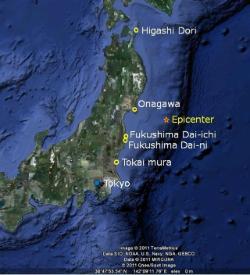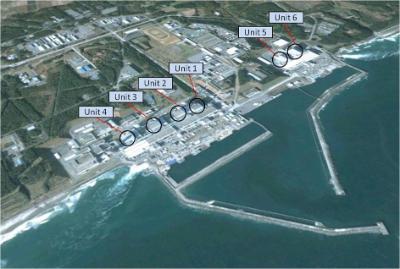The earthquake and tsunami in Japan on 11th March 2011 led to an accident at the Fukushima nuclear power plant.
How did the radioactive plume affect Ireland?
How was the radioactiviy monitored?
How much radiation was the Irish population exposed to?
Further reading and information

The Great East Japan Earthquake and tsunamis on 11th March 2011 resulted in the development of severe accident conditions at the Fukushima Dai-ichi Nuclear Power Plant (NPP) and, subsequently, releases of radioactivity to the environment. The majority of the releases to the atmosphere occurred during the period 12th to 22nd March, with a maximum release phase from 14th to 17th March. The radioactivity released was dominated by volatile fission products including isotopes of the noble gases xenon and krypton; iodine; caesium; and tellurium.
Due to the transit time and significant dilution of the radioactivity in the atmosphere as it was transported across the large distance between Japan and Ireland, increases in levels of radioactivity were expected to be extremely small and not of concern from a public health point of view. However, on reports of the deteriorating situation at the Fukushima Dai-ichi Nuclear Power Plant, on 22nd March the frequency of sampling and analysis of air, rainwater and milk in Ireland was increased in anticipation of the arrival of the radioactive plume in Europe. Similar steps were taken by national authorities across Europe and the world, and data from this monitoring was also used in Ireland’s assessments.
The aims of the monitoring carried out after the Fukushima Nuclear Accident were to assess the levels of radioactivity from the accident reaching Ireland and to provide data on which to base advice to the Government and public.
For a period following the accident at Fukushima, air, rainwater and milk were sampled and analysed more frequently.
The RPII Fukushima report provides a summary of the events which led to the accident at the Fukushima Dai-ichi NPP and sets out the impact in Ireland of the resulting releases of radioactivity.
The RPII 2011 Annual Report presents a comprehensive record and a single point of reference for all of the data generated by the additional environmental monitoring which was performed in Ireland.

The total estimated radiation dose to an adult in Ireland from the additional radioactivity resulting from the Fukushima accident was 0.26 micro-Sieverts (μSv). The typical annual average dose to a person in Ireland from all sources of radioactivity is 4,037 µSv.
The resulting doses were therefore of no significance from a public health or food safety point of view.
Today, the radiation dose to the Irish population from Fukushima is indistinguishable from the normal background radiation we are exposed to.
International Atomic Energy Agency
United Nations Scientific Committee on the Effects of Atomic Radiation